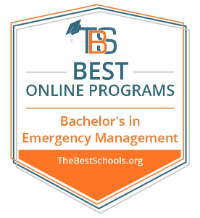What you will study
Prepare to help your community through times of difficulty by developing a deep knowledge
of risk, crisis and disaster management. At the University of Central Missouri, you
can select dynamic classes that cover the application of technology in the field,
safety practices for emergency responders, catastrophic readiness and more. Choose
from one of five areas to focus your studies in:
- Business continuity: Learn how private businesses prepare for, deal with and recover from disasters.
- Emergency management: Develop the skills you need to prepare for, respond to and recover from disasters
that affect the public sector.
- Emergency services management: Build the qualities you need to be a leader and decision-maker in the emergency management
field.
- Environmental hazards: Understand what’s needed to prepare for, handle and recover from disasters such as
earthquakes, chemical spills and diseases.
- Public Health: Understand what’s needed to prepare for, handle and recover from disasters such as
earthquakes, chemical spills and diseases.
Courses focused on practical experience
As part of our Crisis and Disaster Management degree program curriculum, you’ll take
three classes that focus on experiential learning opportunities: Technology Application
Study, Field Exercise Project and Practicum in CDM. Through UCM’s partnerships network,
the real-world experience you’ll gain prepares you for professional success and gives
you job experience to demonstrate on your résumé.
EMT Certification partnership
In partnership with the Johnson County Missouri Ambulance District, UCM offers opportunities
for you to take undergraduate courses that double as requirements for the Emergency
Medical Technician certification. This means you can earn your bachelor’s degree and
your EMT certification at the same time.
Excellence in crisis and disaster management
- #1 : Best Value Bachelor’s Degree College for Crisis/Emergency/Disaster Management in
Missouri (College Factual, 2022)
- A Most Popular Bachelor’s Degree Online Crisis/Emergency/Disaster Management School (College Factual,
2022)
- #1: Best Online Emergency Management Degree Program (Intelligent.com, 2021)
- #11: Most Affordable Bachelor’s in Homeland Security and Emergency Management Degrees
Online (Best Degree Programs, 2021)
- #1: Best Homeland Security, Law Enforcement and Firefighting Colleges for Non-Traditional
Students in Missouri (College Factual, 2021)
- #4: Best Online Bachelor’s in Emergency Management (The Best Schools, 2020)
- #6: Best Online Bachelor’s in Emergency Management Degrees (Best Degree Programs, 2020)
- #12: Best Affordable Online Emergency Management Degree Programs (Bachelor’s) (Affordable
Schools, 2020)
Unique learning opportunities in crisis and disaster management
Gain vital field experience and industry knowledge by getting involved outside the
classroom at the University of Central Missouri.
- Internships: Practice your risk, crisis and disaster management skills in the field before you
start your career by participating in internship opportunities. Past students have
interned at public emergency management departments, fire departments and private
companies, including hospitals.
- Resident program: Live at the Warrensburg Fire Department to learn first-hand what it’s like to work
in emergency response. Go on service calls, network with emergency responders, develop
leadership skills and learn about fire service.
- Professional Conference: Attend local speaking events in your area to hear directly from FEMA personnel, city
and county emergency management directors and graduate program representatives. The
program will support students who have an interest in attending professional events.
What can you do with a degree in Crisis and Disaster Management from UCM?
Courses on risk, crisis and disaster management will provide you with the skills you
need to enter the field or advance in your current organization. Specifically, the
University of Central Missouri prepares you to succeed in roles that encompass:
- Business continuity
- Disaster recovery
- Emergency planning
- Emergency response
- Public safety
- Relief work
To that end, graduates of UCM’s Crisis and Disaster Management degree program have
excelled in these positions at a wide range of organizations, including financial
institutions, state and national government agencies, local fire departments and EMS
companies and corporations.
You can also choose to continue your education in graduate school to better position
yourself for specialized leadership roles. Many CDM students enter master’s programs
such as Sociology or Occupational Safety Management.
Careers with a Crisis and Disaster Management degree
Interact with the tool below to learn more about how risk, crisis and disaster management
skills can help strengthen your career path. Explore job opportunities, salary expectations,
the field’s growth potential and more.
Financial assistance options for your Crisis and Disaster Management degree
The University of Central Missouri works with you to make sure cost isn’t a barrier
to earning your bachelor’s degree. Our affordable tuition puts college within reach,
and our wide range of options to finance your undergraduate education ensures you don’t graduate with a large financial burden.
In fact, LendEDU recognized UCM as a top-ranked university for low student debt. We
offer a wide variety of financial aid options, including:
- Scholarships
- Grants
- Assistantships
- Tuition awards
You can learn about program-specific scholarships at the UCM Scholarship Finder.
Our Crisis and Disaster Management degree program, in particular, has been recognized
by college ranking websites for its value. It often ranks highly for being one of
the most affordable programs for risk, crisis and disaster management in the state
and country.
Meet John S.
BS Crisis and Disaster Management ’17
“The education I received in the CDM program set a foundation for the work I do every
day, whether it’s designing an exercise, drafting emergency plans or just understanding
my community better. I gained valuable, real-world experience through my practicum
that helped me gain a competitive advantage when applying for jobs, but it also taught
me skills that I use on a regular basis.”
Meet Jeff T.
BS Crisis and Disaster Management ’20
“As an adult learner, I had been away from formal education for nearly 12 years. All
of the program faculty were invested in my success, and I was in courses with other
working adults in the same situation I was in. UCM made the process of being an adult
college student much easier. If you’re working in public safety and looking to complete
a degree, I highly recommend you look at UCM.”
leftright

















